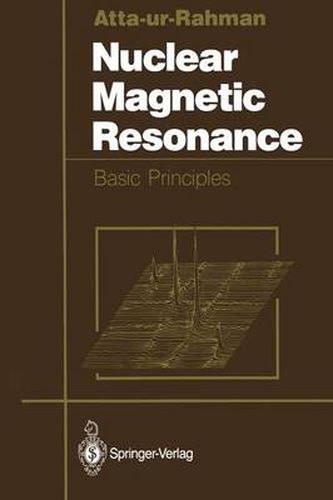Readings Newsletter
Become a Readings Member to make your shopping experience even easier.
Sign in or sign up for free!
You’re not far away from qualifying for FREE standard shipping within Australia
You’ve qualified for FREE standard shipping within Australia
The cart is loading…






This title is printed to order. This book may have been self-published. If so, we cannot guarantee the quality of the content. In the main most books will have gone through the editing process however some may not. We therefore suggest that you be aware of this before ordering this book. If in doubt check either the author or publisher’s details as we are unable to accept any returns unless they are faulty. Please contact us if you have any questions.
Nuclear magnetic resonance spectroscopy is presently going through an explosive phase of development. This has been brought about largely on account of the advent of Fourier transform NMR spectrometers linked to powerful microcomputers which have opened up a whole new world for structural chemists and biochemists. This is exemplified by a host of publications, especially on new pulse sequences, which continue to provide new exciting modifications for recording two-dimensional NMR. Moreover, NMR is no longer confined to structural chemists but has moved firmly into the area of medicine as a powerful nondestructive body scanning technique. With this background, I felt that there was need for a text which would provide a fairly comprehensive account of the important features of 1 H- and 13C-NMR spectroscopy in one book, as well as make available an up-to-date account of recent developments of new pulse sequences, with particular reference to 2D-NMR spectroscopy. Since this book is written for students of chemistry and biochemistry as well as for biology students who have chemistry as a subsidiary, it was decided to avoid a complex mathematical treatment and to present, as far as possible without oversimplification, a qualitative account of 1 H- and 13C-NMR spectroscopy as it is today. I hope that the book satisfactorily meets these objectives.
$9.00 standard shipping within Australia
FREE standard shipping within Australia for orders over $100.00
Express & International shipping calculated at checkout
This title is printed to order. This book may have been self-published. If so, we cannot guarantee the quality of the content. In the main most books will have gone through the editing process however some may not. We therefore suggest that you be aware of this before ordering this book. If in doubt check either the author or publisher’s details as we are unable to accept any returns unless they are faulty. Please contact us if you have any questions.
Nuclear magnetic resonance spectroscopy is presently going through an explosive phase of development. This has been brought about largely on account of the advent of Fourier transform NMR spectrometers linked to powerful microcomputers which have opened up a whole new world for structural chemists and biochemists. This is exemplified by a host of publications, especially on new pulse sequences, which continue to provide new exciting modifications for recording two-dimensional NMR. Moreover, NMR is no longer confined to structural chemists but has moved firmly into the area of medicine as a powerful nondestructive body scanning technique. With this background, I felt that there was need for a text which would provide a fairly comprehensive account of the important features of 1 H- and 13C-NMR spectroscopy in one book, as well as make available an up-to-date account of recent developments of new pulse sequences, with particular reference to 2D-NMR spectroscopy. Since this book is written for students of chemistry and biochemistry as well as for biology students who have chemistry as a subsidiary, it was decided to avoid a complex mathematical treatment and to present, as far as possible without oversimplification, a qualitative account of 1 H- and 13C-NMR spectroscopy as it is today. I hope that the book satisfactorily meets these objectives.